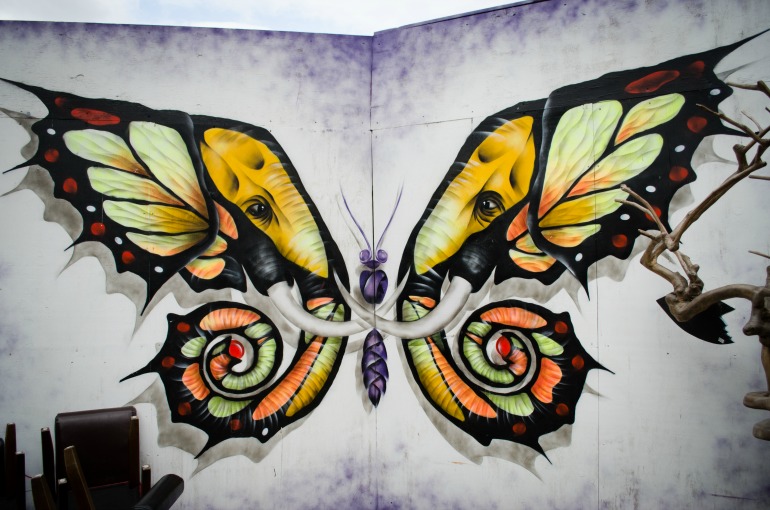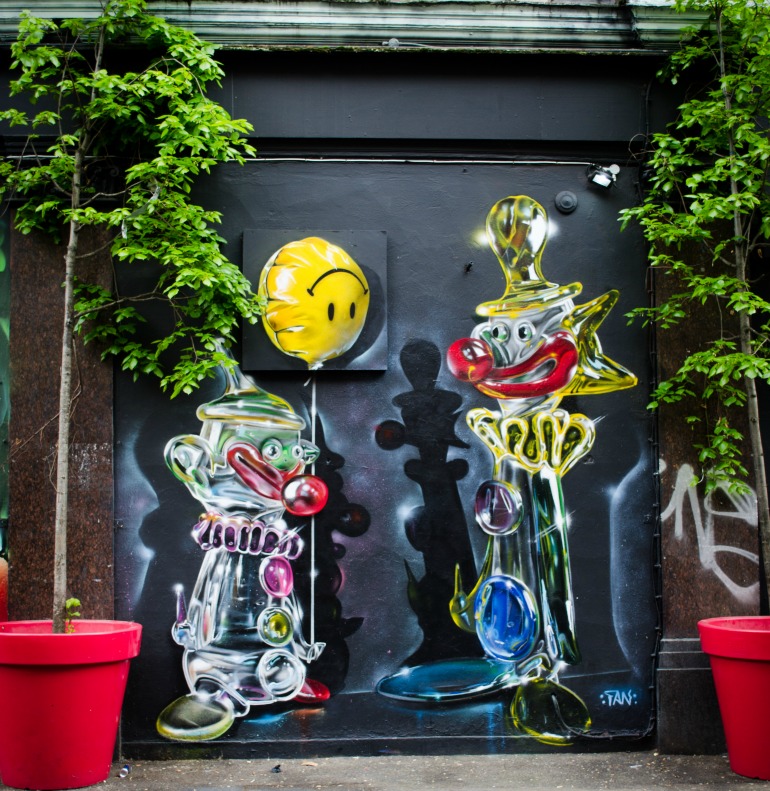There’s a revolution happening in London. But it’s not a political one, or even a social one. Far away from the headline-dominating machinations of governmental Westminster and the bright lights of the glitzy west end theatres, an artistic revolution has been gathering pace in the East End of the city. Into this atmospheric, edgy neighbourhood come the artists, often incognito, to adorn the walls with their creative, talented, sometimes controversial works.
They are many and varied. Not all of them Londoners, many examples of their work can be found in other towns and cities around the world. Many publicise their work on social media, and aficionados will be sure to get to their new pieces before they become tagged or painted over. Here’s a top ten list of things you should know about street art in London.
1. We do have Banksy!
Despite a turf war in the 1990s between supporters of Banksy and supporters of a prolific graffiti writer from the 1980s named King Robbo during which many of Banksy’s pieces were destroyed, we do still have a fair collection in London. You can spot them by the fact they are usually covered with plastic to protect them – Banksy is the most bankable and arguably most famous street artist, and his works sell for millions. Where to find Banksy – Shoreditch; Inside Cargo nightclub terrace on Rivington Street, and Truman brewery yard.
 London Street Art: Banksy – A woman and her shopping trolley falling from a great height. Photo Credit: © Ursula Petula Barzey.
London Street Art: Banksy – A woman and her shopping trolley falling from a great height. Photo Credit: © Ursula Petula Barzey.
2. There is so much more than Banksy!
Some of the most eye catching street art is by people you’ll never have heard of, but that doesn’t mean they are not worth finding – in fact, the opposite is true! Names such as Fanakapan, Stik, Otto Schade, This One, Mobstr and Clet Abrahams are regulars on Londons streets and are all fantastically creative. Where to find them – Brick Lane and the offshoot roads around them – a guided tour with a Blue Badge Tourist Guide is the best way to find the hidden gems.
 London Street Art: Otto Schade – Elephutterfly. Photo Credit: © Alex Lacey.
London Street Art: Otto Schade – Elephutterfly. Photo Credit: © Alex Lacey.
3. Street art isn’t all huge painted walls.
The key to finding street art is looking up, down, low, high, around and behind things. Some of the most fun pieces are tiny, such as Dr Cream’s Rolling Fools which are small plaques of a snail with jester’s head – when you put lots together in a video, they form a stop motion clip. Or Clet Abrahams, who adds stickers to road signs with great effect. Or Jonesy, who makes little pieces out of bronze and hides them where you least expect. Where to find them – lots in Shoreditch, but all over London too. in the places you’d least expect to look!  London Street Art: Fanakapan – Shoreditch Clowns. Photo Credit: © Alex Lacey.
London Street Art: Fanakapan – Shoreditch Clowns. Photo Credit: © Alex Lacey.
4. There is something for everyone.
Don’t like the piece you’re looking it? Look all around you, there’s bound to be another one just nearby, maybe one that is more to your taste!
 London Street Art: Louis Masai – Coral Biodiversity. Photo Credit: © Alex Lacey.
London Street Art: Louis Masai – Coral Biodiversity. Photo Credit: © Alex Lacey.
5. A lot of the pieces are illegal.
To do a legal piece, you need to obtain permission from the owner of the building. No permission, and no matter how lovely your piece, it’s illegal! Many artists started out doing illegal tags. A tag is your signature done in spray paint. Those seemingly illogical graffiti scribbles you see on walls all over the world? Those are tags. Not all taggers go on to be street artists, but many street artists started out as taggers. Some still enjoy going out and tagging, as it’s considered the purest form of graffiti.
 London Street Art: Otto Schade – Children pointing weapons at joker figure. Photo Credit: © Alex Lacey.
London Street Art: Otto Schade – Children pointing weapons at joker figure. Photo Credit: © Alex Lacey.
6. There are more female street artists than ever.
Traditionally fairly male dominated, street art is attracting more and more women to its ranks. Some of the ones you can spot around London include C3, who sticks up paper cutouts (known as wheat pastes) of stylised retro-style women, all adorned with a heart, and created out of old financial newspapers. China Girl creates china tiles of a variety of images, often woodland creatures, with an emphasis on highlighting modern surveillance culture. Amara Por Dios offers up beautiful coloured deities, and is an absolute whizz at drawing with both hands at once! Where to find them – Brick Lane and Spitalfields are great for these artists.
 London Street Art: C3 – Peek A Boo. Photo Credit: © Alex Lacey.
London Street Art: C3 – Peek A Boo. Photo Credit: © Alex Lacey.
7. They are proper artists.
Many artists have been to art school. Lots are influenced by other artists, the sort you’d find in the finest galleries London has to offer. Take, for example, Jimmy C, a self-described spray paint pointillist. Compare his work to that of the 20th century artist Georges Seurat at the National Gallery, and you’ll see a lot of similarities between his way of dotting the colour to make up the whole piece. What’s more, unlike the National Gallery, you stand a chance of running into some of the artists when on a tour of the area!
 London Street Art: Jimmy C – Joe’s kid. Photo Credit: © Alex Lacey.
London Street Art: Jimmy C – Joe’s kid. Photo Credit: © Alex Lacey.
8. You can buy street art!
Many street artists make a living from their art. Some have a studio where they will create works to sell. If you find an artist you like, check out their website or their Instagram feed, you might find they have something for sale.
 London Street Art: Mr Cenz – Beautiful Woman on Fashion Street. Photo Credit: © Alex Lacey.
London Street Art: Mr Cenz – Beautiful Woman on Fashion Street. Photo Credit: © Alex Lacey.
9. By night, the open air gallery changes completely!
As the shops shut, the shutters come down and reveal the work that has been painted on them. Things that you can’t see during the day are suddenly on show, and it’s like a completely different exhibition. Keep an eye out for Zabou, a female artist who has painted lots of shutters with brightly coloured portraits – at night, her work is everywhere, and slinks quietly back out of view as the next day dawns. Also look out for Bastardilla, another female artist, who includes glitter in her work, so by night it shimmers and twinkles as the lights flicker. Where to find them – Zabou is all over shutters on Brick Lane, and Bastardilla has a very clear piece on Pedley Street – but look up to find it!
 London Street Art: Zabou – Cabinet of Curiosities. Photo Credit: © Alex Lacey.
London Street Art: Zabou – Cabinet of Curiosities. Photo Credit: © Alex Lacey.
10. The average life of a street art work in London is 4 weeks.
Every time you take a tour of the area, you’ll probably see a completely new set of street art. Unlike Brazil, the homeland of street art where many murals are 6 years old or more, there’s a more transient approach to it in London. Fanakapan has said that some of his best works have lasted days, whereas ones he thinks weaker just simply won’t die! Some artists come and paint over their own work with something new, just because they feel it needs a change. So come armed with a camera, and come back more than once!  London Street Art: Meeting of styles. Photo Credit: © Alex Lacey.
London Street Art: Meeting of styles. Photo Credit: © Alex Lacey.
London’s Street Art scene is vibrant and ever-changing so the best way to enjoy it is on a tour with a Blue Badge Tourist Guide. They keep themselves updated so that you will see the latest and best works.







Leave a Reply